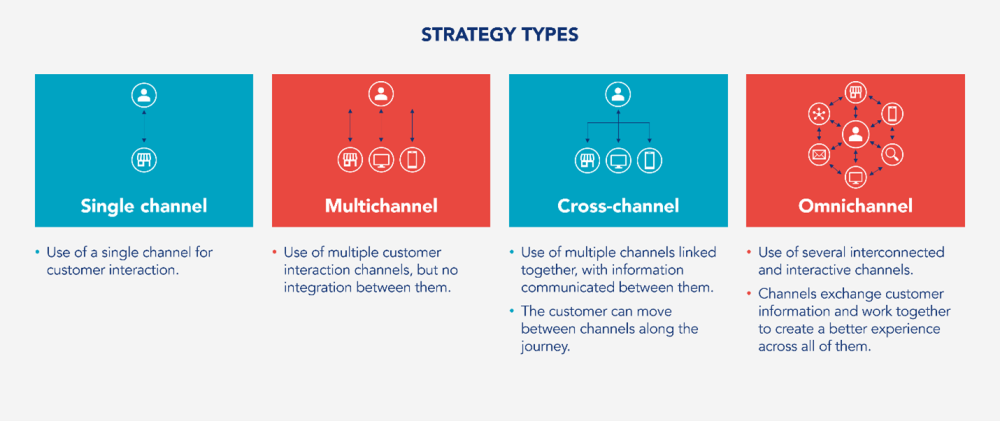An omnichannel experience in which companies provide a seamlessly integrated set of channels that cater to customers’ preferences, and actively guide them to the most efficient option, is increasingly a survival imperative.
Implementing an omnichannel strategy requires focus. Companies must look at their strategic priorities to decide who they want to be from an omnichannel standpoint. After defining this, it is necessary to establish a plan to implement this ambition, focusing on the two or three journeys that are most important to the customer to maintain focus.
What is omnichannel?
Omnichannel is a strategy that aims to create a seamless shopping experience from the first point of contact to the last, regardless of the channel used. The goal is for the customer journey to flow seamlessly and effortlessly, with all the channels prepared and integrated to meet their needs.

In this strategy, the channels are all interconnected and interact, working together to enable the best engagement with the customer and create an outstanding experience with the brand. These channels include online stores, social media, mobile apps, physical stores, call centers, chatbots, or any other channel.
What are the benefits of an omnichannel strategy?
An omnichannel strategy aims to make life easier for customers throughout the journey, eliminating all pain points during the engagement with the brand. An omnichannel approach allows you to increase customer satisfaction and sales.
The main benefits of omnichannel are:
Efficiency in service
The integration between channels allows for greater agility in service, ensuring greater customer satisfaction regarding the company. The process becomes more seamless and faster, solving problems with more assertiveness. By operating on different channels, customer support can be offered on a more extended schedule.
Information quality
Centralizing information on a single platform prevents the customers from providing all the information each time they contact the company since the teams have access to all the information, regardless of the channel. This conveys a sense of organization, consistency, and security.
Strengthening the brand relationship
The omnichannel makes it easier for the company to build a relationship with the customer. It allows a better understanding of their most significant pain points and needs, making it possible to create strategies focused on the persona.
Cost reduction
By centralizing all information in one place, processes are streamlined and operating costs generally decrease. Marketing investment can also be reduced because more satisfied consumers tend to become brand advocates, thus helping to generate spontaneous publicity.
Sales opportunities optimization
With several channels available, it is only natural that the probability of the customer making a purchase increases. By sharing information across channels, companies can also better make suggestions to customers according to their profiles.
The challenges of an omnichannel strategy
The idea that implementing omnichannel requires a considerable amount of time and resources can become daunting and hold some companies back. Not all those that attempt implementation succeed in building a truly comprehensive customer experience.
Some of the most common challenges in implementing omnichannel are:
Multichannel management
Nowadays, you can hardly solve customers’ needs through a single channel. The increased number of available channels implies greater complexity in their management.
Resource allocation per purchase type
Distributing the resources among various channels (in-person, remote, and self-service) is necessary. Companies must organize themselves to use the most appropriate channels for each type of purchase. Typically, in-person resources for higher value or more complex sales, and self-service sales for lower value or less complex transactions; there may be exceptions.
Channel conflict management
Managing channel conflicts requires rethinking sales team incentives, redesigning sales territories, and an overall change management effort.
Integration of marketing, sales, and customer service
It is crucial to ensure that marketing, sales, and customer service teams work together to improve the overall customer experience. The leaders of these teams must have a strong relationship and aligned goals.
Despite the challenges, a company can design an outstanding omnichannel experience for most of its customers, and it should focus on the two or three customer journeys that are most important to that majority. Defining the right plan for omnichannel implementation requires a customer-centric mindset pervasive throughout the organization.
Key factors for a good omnichannel marketing strategy
For the customer to have a good experience with the brand, there are four essential factors:
- Presence: Customers have less time on their hands, meaning being present in the most convenient channels is a fundamental principle for a good experience.
- Consistency: Consistency is vital in building an omnichannel experience. It is necessary to ensure a unique message and brand image that consumers can trust.
- Customization: The new consumer expects interactions to be real-time, highly customized, tailored to buying preferences, and with an understanding of the customer’s transaction history and interactions with the brand.
- Agility: Companies must adopt tools and analyses that recognize market behavior and enable quick action when opportunities present themselves.

To put the omnichannel experience into practice, it is necessary to have skilled teams and technologies that enable the correct sharing of customer journey information. In the area of technologies, CRM platforms are of fundamental importance in implementing an omnichannel strategy.
Omnichannel as a competitive advantage
Companies that manage to effectively implement omnichannel gain a competitive advantage. An omnichannel strategy can be a manageable and achievable aspiration when implemented with focus. By concentrating resources on the channel journeys that customers value, organizations are able to provide the best customer service when it matters most. This results in increased customer loyalty and increased sales.
See more on Marketing & Sales
Find out more about improving this business area
